Is the blockchain a "Hierarchical" or an "Equalitarian" Community?
Is the blockchain a "Hierarchic" or an "Equalitarian" Community?
Society and Non-paternalistic Social Utopias
This post continues the reflections of my last post Is the blockchain a Realizable Social Utopia?, to find the path to sustainable non-paternalistic social utopias in the blochchain.
We realized that everybody in the blockchain communities must have access to all the vision, information and structure used, and the best possible answers to solve everibodies needs, so that anyone can understand it and compare to other social organizations, and that we must avoid secrecy or self-interested groups.
We have seen that Paternalistic Social Utopias conducts to Hierarchical societies and Non-paternalistic Social Utopias leads to Equalitarian* societies.
On the other side we have seen that realizable utopias rise with the discontent of the so called "Universal Utopia" of "one size for all", being introjected in peoples' minds by the two "evils" of our time, the "State Mob" and "the Mass Media Mob".
This two "evils", "act in our name and against our interests" in this modern times of savage capitalism, very well defined by Al Capone - "Capitalism is the legitimate racket of the ruling class".
In this state of things, the members of the new blockchained communities must find ways to stop the dissatisfaction, discuss and choose the best ways to solve it, and generate social consent on the way to solve everybody's needs to facilitate free choice in a decentralized equalitarian society.
Yona Friedman gives us a simple language to easily recognize the structures of society and understand the differences from any other.
Let's define a language to understand the problem using graphics and maps to mathematically represent society.
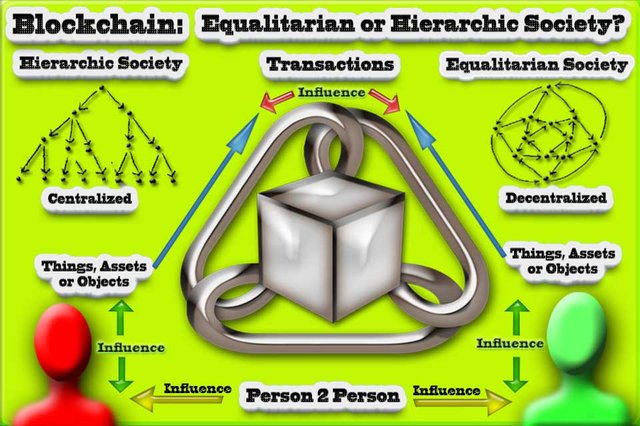
1 - Social Utopia as a language - What is Society and Environment?
I will start by some conclusions and then I will explain the steps to understand it, in the point of view of any person outside the system and wants to observe it without being envolved..
In this model we are going to create a language, that allows any external observer to watch and register it, so that using this mathematical grid to watch that phenomena all the observers will do the same notation and conclusions.
In this mathematical language, Connection Graphs and Maps of Influence are a model of thinking and possible data collection, in which Society and Environment have the same meaning in a world of people interacting, mediated and interrelated to Objects of the material world.
"Society is individuals in relation and interaction" and everyone that is not in it is "outside society".
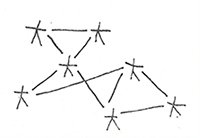 a) - Individual as a Chain with others.
a) - Individual as a Chain with others.
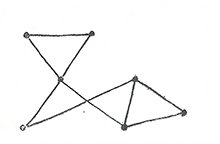 b) - Map of society called in math connect graph.
b) - Map of society called in math connect graph.
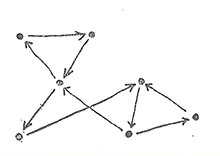 c) - Direction of a relation and communication with mutual influences with noticeable directions of propagation.
c) - Direction of a relation and communication with mutual influences with noticeable directions of propagation.
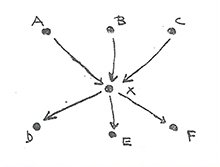 d) - One among others with the map of influences given and received that have a force or strength.
d) - One among others with the map of influences given and received that have a force or strength.
So one Social person = sum (arrows in) + sum (arrows out).
In this view society is a balance of influences in a community.
The arrows have the same size because we cannot measure or quantify it and on the other hand what is given and received as a low level self and global consciousness.
There are direct influences between peers as well as indirect influences coming from other peers outside of that peers in mutual influence. As intermediaries of that influence sometimes make mistakes in the transmission of the content of the message, it diminishes and degradate that initial influence. So mathematically one Person in Society = [Sum(direct influences on others)+ Sum(indirect influences on others)] - [Sum(direct influences received from others) + Sum(indirect influences received from others)]. Now we are ready to understand the description of the "mathematical structure of a Society" using a graphic map of propagation of influences and/or the "path-matrix" to determine influence degradation. So there will be a change in the structures by the reallocation of power and a transformation of the hierarchical structure into a new substructure. In societies graphically represented by a "tree"
if any "root" members leave it, creates a "degressive hierarchy" and a progressive balance of "alliances" based on the "root" top power generating a high degree of instability in this kind of structures. In an equalitarian society all the peers have the same social situation creating a big degree of stability. The graphics show the mathematical structure of society and the Map of total mutual influences. The blockchain is a Realizable Social Utopia, within a new singular "Realizable Technological Utopia" that permits the transaction of financial values and things or objects in a P2P = Person to Person network . Anarcho-capitalism, the blockchain or Steemit are Equalitarian Communities in relation to people, but there is a Hierarchical Society in relation to Objects or assets (economy). And never forget that both utopias can become paternalistic if some members decide to conspire for their needs, instead of the needs of all the community. I've been thinking and I'm still confused, if the blockchain is now over the 7th layer of data communication, creating the 8th layer of Representation of Intelligent Agents ( connections, interactions- influences - object transactions) in topological data matrices, a new language of Society as an Environment of Objects + People's peers, that are the "others" for each one of us. The Vision and Mission of the creators of the blockchain must be clear, transparent and transmitted, as well as the best possible solutions for all the members to solve their problems and needs and they have to share the same needs of all the community, as the main condition for avoiding the path of Paternalistic Social Utopias. The blockchain can become equalitarian in relation to Man, but is still hierarchic in relation to Objects, So this dream, for now, is just a romanticized dystopian view of non-realizable Utopia "Objects are an influence to Man as Man is influenced and influencing other Man ". Free and open Knowledge brought the possibility of a social non-paternalist equalitarian society in relation to the influences of man, and a possibility the utopia of a better redistribution of objects generating a lower hierarchic pyramid in the gap of wealth and possession. On the other hand, this singularity and technological Utopia, where the world of Objects is still hierarchic, doesn't bring the solution to this problem of egalitarianism. But with the generosity and heart of some ideas and projects of the creators in the blockchain, like the UBI (Universal Basic Income), we can help to reduce and equilibrate the gap between the ones who have it all and the ones that have almost nothing. Most of the creators of blockchains have beautiful ideas and visions to change the world, but sometimes the chain of communication of their vision and mission is not very clear to all the members and newcomers, causing the emergence of self-interested groups or individuals that drain the synergy of all and transform it in non-paternalistic social and technological utopias. And I'll finish with a quote of Yona Friedman: The psychological key to freedom, adaptation, and relation of peers, in the construction of consensus, based on the needs of all the members, as a standpoint for " New Universal Order " courtesy of Source-Code and the Blockchain (*) I choose the term Equalitarian for a vision that accepts or promotes the view of equalitarianism , instead of Egalitarian a vision who accepts or promotes social equality and equal rights for all people because that is not yet possible in the material hierarchic structure of our world of objects and assets. An Ode to the blockchain - the Dialectic of Liberation Steemit: Vision, Mission, Values and Strategy Steemit Value : Intangible Asset vs Tangible Asset Analysis Steemit: Altruism and Financial Scarcity and the rise of Advertising Steemit : The Shrinking of the Money Pie and the Rise of Human Pie All black and white pictures are originally copied from the book - "Utopias Realizáveis" by Yona Friedman , Sociocultur, Lisbon, 1977 (in Portuguese) (1) Yona Friedman - wikipedia : Architect, urban planner, designer but also a sociology student, physics and science communications, Yona Friedman (Budapest, 1923) is back at the center of international architectural culture after having long been dismissed as Utopian.
Member of the Hungarian anti-Nazi resistance, Friedman spent a few years in Haifa, Israel, where he sketched the first of his many theories, namely the Mobile Manifesto architecture in which special construction systems allow the inhabitant to determine for itself the shape, style etc. his apartment and to change it when they want it. website: Yona Friedman Interview with Yona Friedman: "Imagine, Having Improvised Volumes "Floating"In Space, Like Balloons" Yona Friedman 1000+ photos - Pinterest Utopies réalisables by Yona Friedman Comment vivre entre les autres sans être esclave et sans être chef, J.J. Pauvert, Paris, 1974 The Politics of Utopia: A Study in Theory and Practice By Barbara Goodwin, Keith Taylor One Video among hundreds : Yona Friedman: You are obliged to stay Mainstream e) - Man as direct or indirect influence on others
e) - Man as direct or indirect influence on others
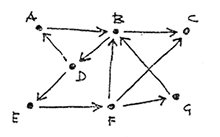 f) The degradation of the influence is inversely proportional to the number of transmissions.
f) The degradation of the influence is inversely proportional to the number of transmissions. Yona expresses in this formula that he calls "Path-Matrix".
Yona expresses in this formula that he calls "Path-Matrix".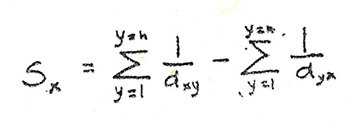 It depends totally on the type of topological properties ot that society are hierarchical or equalitarian.
It depends totally on the type of topological properties ot that society are hierarchical or equalitarian.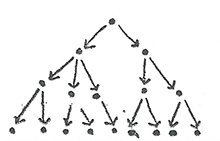 In Hierarchical society if one member leaves the community some lose and some win, because this structure generates fights for power within a frame of "alliances" and "adversaries" based in old dependencies.
In Hierarchical society if one member leaves the community some lose and some win, because this structure generates fights for power within a frame of "alliances" and "adversaries" based in old dependencies.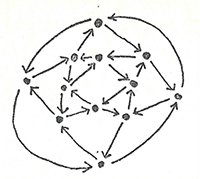 If one member leaves an equalitarian society all the peers remain in the same social situation and the structure is not changed.
If one member leaves an equalitarian society all the peers remain in the same social situation and the structure is not changed.We can accept social difference in the possession of wealth in social situations, but only under the condition that every human being in the world has enough to provide basic needs to all born Earthlings (UBI -Universal Basic Income).
2- Blockchain: Equalitarian or Hierarchical Society
Society as Men and Objects
"The others are different for each one of us"
Footnote:
All phrases with commas are citations of Yona Friedman's books
My other posts on Steemit about the blockchain
Is the blockchain a Realizable Social Utopia?
B/W Pictures Source:
References:
Books:
Hello @charlie777pt,
Congratulations! Your post has been chosen by the communities of SteemTrail as one of our top picks today.
Also, as a selection for being a top pick today, you have been awarded a TRAIL token for your participation on our innovative platform...STEEM.
Please visit SteemTrail to get instructions on how to claim your TRAIL token today.
If you wish to learn more about receiving additional TRAIL tokens and SteemTrail, stop by and chat with us.
Happy TRAIL!
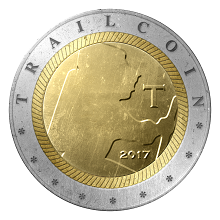
This post has been ranked within the top 10 most undervalued posts in the second half of Jan 11. We estimate that this post is undervalued by $23.48 as compared to a scenario in which every voter had an equal say.
See the full rankings and details in The Daily Tribune: Jan 11 - Part II. You can also read about some of our methodology, data analysis and technical details in our initial post.
If you are the author and would prefer not to receive these comments, simply reply "Stop" to this comment.
Thanks a lot for this award. :)
And thanks for the motivation to write better posts with meaningful content.
Thanks for helping to fulfill the vision and mission of steemit to retain and attract good bloggers and curators.